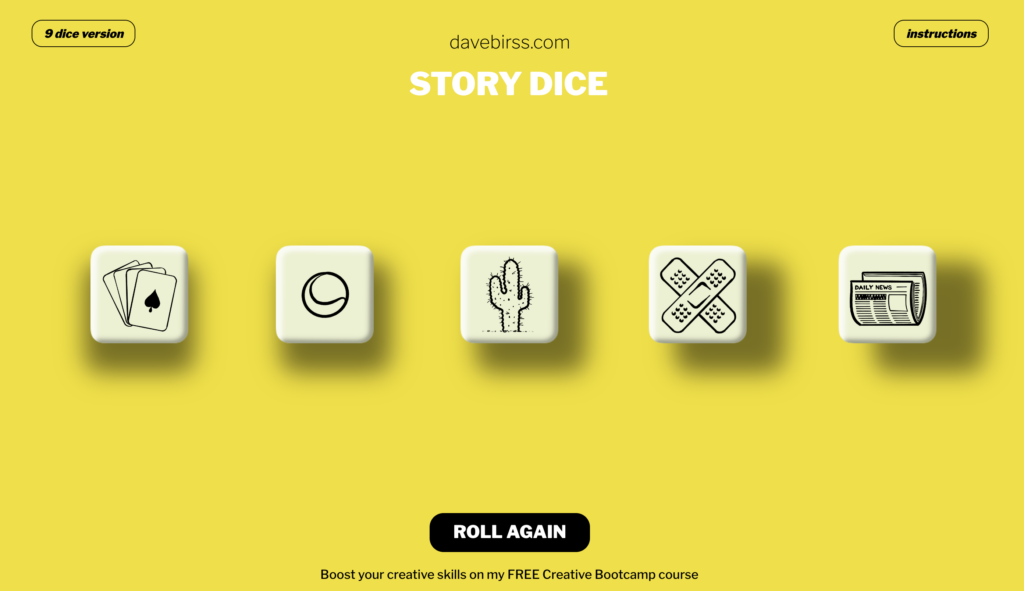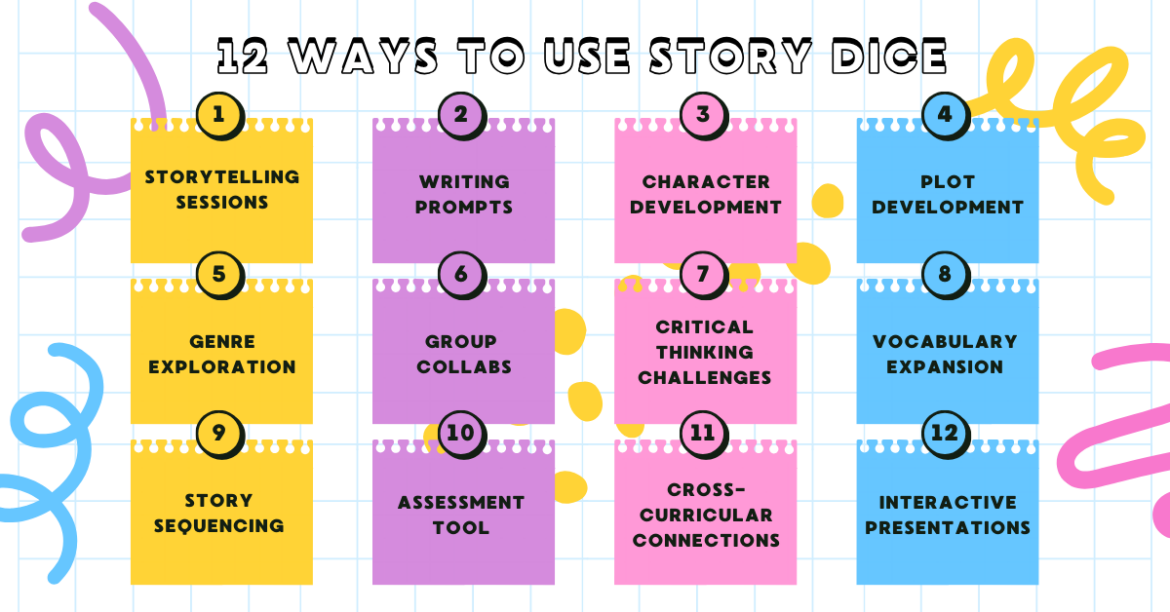As educators, we constantly strive to foster creativity and imagination in our students. But how do we inspire them to think outside the box and craft compelling stories? Enter story dice – a fun and effective tool for sparking creativity in the classroom.
About Story Dice

Dave Birss created a digital story dice generator. The dice feature different images, with over 50 options for each dice. You have the option of choosing five dice or nine dice. This is a handy tool if you are looking for inspiration to create fun story ideas. The more it is used, the better the storytelling will become.
How to Use Story Dice
Roll the dice, and random images will appear. Your job is quite simple: turn the images into a story! It is recommended that you work with the order they appear on the screen, but if you’re finding it tough, you can mix them up.
According to Birss, you also don’t need to take the image literally. You can use the dice metaphorically or as representations of other concepts. For example, a slice of pizza could represent food in general, cutting a slice out of something, Italy, gooiness, or a chef. The job of the dice is not necessarily to provide you with literal objects to work with but concepts to nudge your thinking in fresh directions.
When writing your story, you can work from beginning to end as you try to incorporate each image. Or you may want to be more strategic and work out the ending first. Try different strategies to see what works best for you!
Two Sample Stories Using Story Dice
Below are two sample stories inspired by story dice written by TCEA Directors of Professional Development, Peggy Reimers and Miguel Guhlin.
Story by Peggy Reimers, Director of Professional Development, TCEA:

Startled from a nap by a BIG BANG, I reached for my glasses. Looking around, I noticed my dog Boo was trying to climb the ladder to get to those pesky squirrels. He must have misstepped because he was out cold on the ground. Good thing he didn’t fall into the Saguaro cactus I just planted. Boo is okay! He shook it off and now is wagging his tail. His tumble will not make the daily news. Well, I guess I better get to my chore of the day: vacuuming.
Story by Miguel Guhlin, Director of Professional Development, TCEA:

It was a humid Saturday morning in the summer of 1978 in Los Rios, Canal Zone. Seven-year-old Juan raced barefoot through the dew-soaked grass, chasing his energetic beagle Adgu around the yard. The rising sun painted the sky in vibrant oranges and pinks as flocks of parakeets chattered noisily in the sprawling mango tree that dominated the landscape. Bright green iguanas darted to and from, startled by the boy and dog’s antics.
Juan’s father stepped out onto the porch, a steaming mug of coffee in one hand and the Daily News newspaper in the other. “Juan! Breakfast is ready!” he called out. The boy reluctantly abandoned his pursuit and bounded inside, Adgu yapping at his heels.
In the kitchen, Juan plopped down on the squeaky swivel office chair his dad had rescued from the Canal Zone administrative offices. His mom set down a plate heaped with pancakes, a knife and fork nestled invitingly on either side. “Hurry up and eat, mi hijo. We need to go into town for groceries,” she said, ruffling his sleep-tousled hair.
As Juan shoveled forkfuls of syrup-drenched pancake into his mouth, his eye was drawn to his father’s toolbox sitting on the counter. The shiny needle-nose pliers peeked out, and Juan remembered his plan to fix his broken toy car. “Papi, can I borrow your pliers after breakfast?”
His father nodded absentmindedly, engrossed in an article about the ongoing Panama Canal treaty negotiations between President Carter and General Torrijos.
Juan wolfed down the rest of his pancakes, eager to get to work. As he brought his empty plate to the sink, he spotted a mousetrap tucked behind the breadbox. The family had been battling a clan of clever mice that kept raiding their pantry. Juan shuddered, hoping he wouldn’t encounter any of the furry bandits while retrieving his toy car from under his bed.
Grabbing the pliers, Juan dashed off to begin his repair project, Adgu close behind. It was shaping up to be another ordinary, extraordinary day in the life of a young Zonian amidst the political upheaval and natural wonders of the Panama Canal Zone.
12 Ideas for Using Story Dice in the Classroom
Teachers can use story dice in various ways to promote creativity, critical thinking, and communication skills among students. Here are some ideas for incorporating story dice into classroom activities.
Storytelling Sessions
Roll the story dice and have students use the dice images to create a cohesive, verbal story. This activity promotes narrative development, imagination, and oral communication skills.
Writing Prompts
Roll the story dice to generate writing prompts for creative writing exercises. Students can use images as inspiration to write short stories, poems, or journal entries.
Character Development
Use the story dice to inspire character development activities. Roll the dice and ask students to determine traits, backgrounds, and motivations for characters in their stories or role-playing scenarios.
Plot Development
Guide students in using the story dice to develop plots for their narratives. They can roll the dice multiple times to determine key plot points, conflicts, and resolutions.
Genre Exploration
Roll the story dice and challenge students to create stories within specific genres, such as fantasy, mystery, science fiction, or historical fiction. This encourages students to explore different literary styles and conventions.
Group Collaborations
Divide students into small groups. Have them roll the dice collectively and collaborate on building a story together. They could even do a chain story, where a student writes the first sentence with the first dice, and then the second student has to add a sentence incorporating the second dice, and so forth. This fosters teamwork, negotiation skills, and creative problem-solving.
Critical Thinking Challenges
Use the story dice to pose critical thinking challenges. For example, roll the dice and then ask students to identify the main conflict, climax, and resolution in a story based on the images they land on.
Vocabulary Expansion
Use story dice with younger students to introduce new vocabulary words. Roll the dice and then incorporate the words they land on into sentences or short stories.
Story Sequencing
Roll the story dice and ask students to sequence the images or words in the order they were rolled. This activity helps students practice sequencing skills and logical thinking.
Assessment Tool
Story dice can be used as an informal assessment tool to gauge students’ understanding of literary elements such as setting, characters, plot, and theme. Roll the dice and explain how they would incorporate the elements into a story.
Cross-Curricular Connections
Integrate story dice into cross-curricular activities by combining storytelling with other subjects, such as science, social studies, or art. Students can create stories that incorporate concepts from multiple subjects.
Interactive Presentations
Incorporate story dice into interactive presentations or classroom discussions to engage students and facilitate participation. Roll the dice to introduce topics or spark conversations related to the lesson.
By incorporating story dice into your classroom activities, you can ignite your students’ imagination, foster creativity, and promote storytelling skills in a fun and engaging way. So roll the dice, let the story unfold, and watch as your students embark on unforgettable storytelling journeys.

